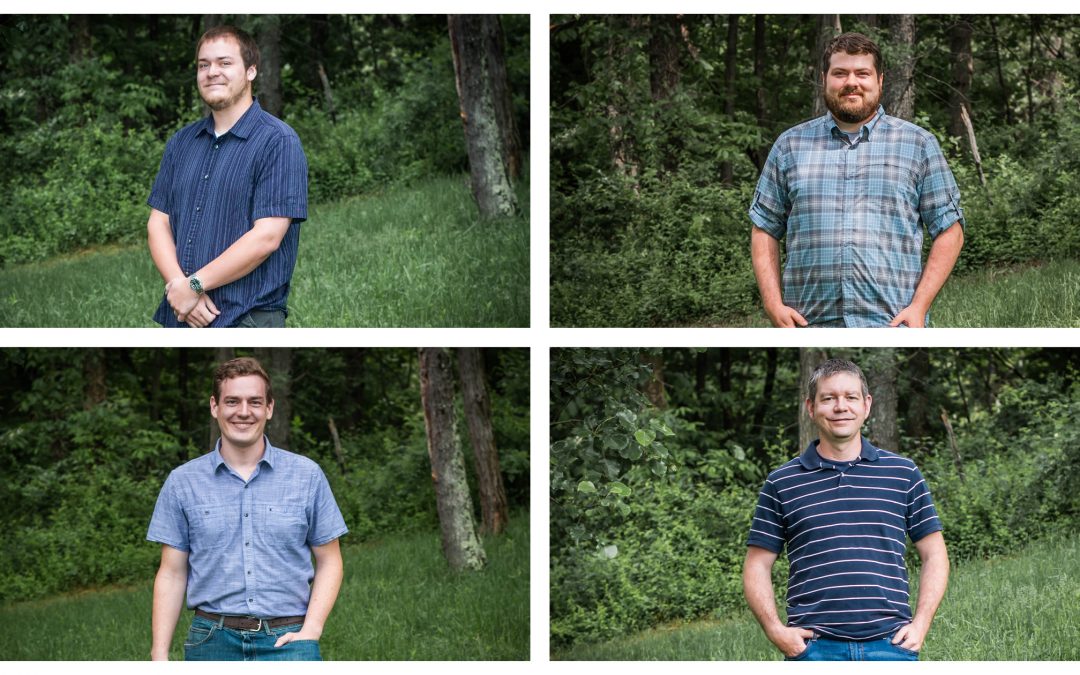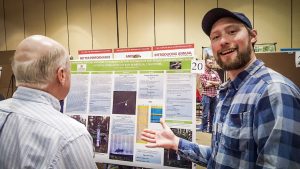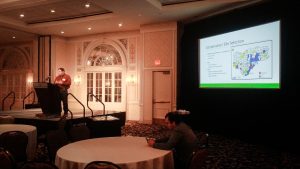
by Derek Springston | May 22, 2019 | Aquatic, Bat Services, Mussel Surveys, News, Permitting, Stream & Wetland Permitting
AllStar Ecology is excited to announce the addition of four new staff members with a wide range of biological and environmental experience and expertise.
Matthew Gilkay, Environmental Scientist I / Aquatic Biologist, is assisting AllStar with freshwater mussel surveys, flow monitoring, macroinvertebrate field and laboratory work, and water quality sampling. Matt obtained his B.S. in Fisheries, Wildlife, and Conservation Biology with minors in Environmental Science, Sustainability Studies, and Marine Biology in 2018. Mr. Gilkay also brings six years of open-water SCUBA diving experience in the Upper Midwest to AllStar’s dive team.
Grant Maltba, Environmental Scientist II / Bat Biologist, has joined our Bat Services team bringing eight years of experience in environmental services. Grant has a Federal Recovery Permit and West Virginia Scientific Collecting Permit for Indiana, gray, and northern long-eared bats. In 2013, he obtained his B.S. in Environmental Studies. Mr. Maltba is assisting AllStar with bat mist netting and acoustic surveys, bat box construction and installation, permitting and report writing, and bat habitat research.
Matt Safford, Environmental Scientist I / Bat Biologist, has also joined AllStar’s Bat Services team with five years of experience in wildlife and ecological monitoring and research. Matt obtained his B.A. in Ecology in 2013 and his M.S. in Entomology in 2018 studying the interactions between bats and their insect prey. Mr. Safford has a West Virginia Scientific Collecting Permit for bats and is assisting AllStar with bat box construction and installation, mist netting and acoustic bat monitoring, report writing, and bat habitat research.
Jason Clingerman, Environmental Scientist II, has joined our Stream and Wetland Delineation team. Mr. Clingerman has 8 years of experience in environmental consulting, and 12 years of experience utilizing GIS for various natural resource applications. He obtained his B.S. and M.S. in Wildlife and Fisheries Resources in 2005 and 2008, respectively. He is assisting AllStar with stream and wetland delineations, permitting, and report writing.
Please join us in welcoming these four great additions to the AllStar Team!
To read more about AllStar Ecology, visit our About Us page.
TALK WITH US
Thanks for reading!

by Ryan Ward | Apr 13, 2018 | Bat Services, News
AllStar Ecology was well represented at the Joint Bat Working Group Meeting in Roanoke, VA. The March 27-29, 2018 meeting was an assemblage of the Northeast Bat Working Group, Midwest Bat Working Group, the Southeastern Bat Diversity Network, and the Colloquium on the Conservation of Small Mammals.
Malachia Evans, AllStar Ecology Bat Biologist, presented a poster on the use of AllStar Ecology artificial roosting structures by northern long-eared bats. Bats utilized 73% of the sites where AllStar installed roosts and rocket boxes saw a 24% increase in use during their second year on the landscape. AllStar’s landscape modeling also showed to be a useful tool for roost placement. Click here to download Malachia’s poster: Artificial Roost Use by Northern Long-Eared Bats in West Virginia from 2016-2017 – Malachia Evans & Eric Schroder (pdf)

Neil Lafleur, AllStar Ecology Bat Biologist, presented a poster on his development of a bag trap to catch bats utilizing AllStar built rocket boxes. Neil’s trap design boosted our catch rate of bats monitored in rocket boxes from 60% to 94%.

Jesse De la Cruz, former AllStar Ecology Bat Biologist, is now with the Conservation Management Institute out of Virginia Tech. Jesse gave an oral presentation on roost use by northern long-eared bats which represented work he conducted with AllStar and further research with CMI.

Eric Schroder, AllStar Ecology Bat Biologist, gave an oral presentation on recently published research on Indiana bats from his Masters thesis work at Western Illinois University. Click here to download Eric’s article and presentation: Indiana bat maternity roost habitat preference within Midwestern United States upland Oak-Hickory forests – Eric Schroder (pdf); Indiana Bat Maternity Roost Preference within Midwestern United States upland Oak-Hickory Forests – Eric Schroder (pdf)

Philip Arant, new AllStar Bat Biologist, gave an oral presentation of work he recently completed for his Masters thesis at the University of Kentucky. Philip will continue to help with this research into forest management techniques and the effects on northern long-eared bats in his new role with AllStar.

Ryan Ward, Senior Environmental Scientist/AllStar Ecology Owner, gave an oral presentation on AllStar’s development of conservation sites for rare, threatened, and endangered bats. He covered site selection and various conservation measures such as artificial roosts, potential roost tree creation, reforestation, and hibernacula protection.

For information on topics related to our bat program and the upcoming bat season, please contact Eric Schroder at 304-816-3490.

by Derek Springston | Oct 10, 2017 | Bat Services, News
Eric Schroder, AllStar Ecology Bat Biologist, was recently the lead author on a journal article titled “Indiana bat maternity roost habitat preference within Midwestern United States upland Oak-Hickory (Quercus-Carya) forest”. The article focuses on the Indiana bat, a federally listed endangered species, and the complex combination of tree and landscape characteristics in influencing habitat preferences. The article is featured in the November 2017 version of Forest Ecology and Management.
Read the article here:
Indiana bat maternity roost habitat preferences within Midwestern United States upland Oak-Hickory (Quercus-Carya) forests

by Eric Schroder | Apr 25, 2017 | Bat Services, News
Importance of Bat Habitat Assessment and Conservation
As industry development continues across the country, Indiana bat (Myotis sodalis) and northern long-eared bat (Myotis septentrionalis) habitat conservation is important to maintain their populations. Indiana bats and northern long-eared bats are listed as federally endangered and threatened species, respectively. During the summer, they are both forest dwelling bats that will roost underneath the peeling bark or within cracks, crevices, or cavities of trees. During the winter, both species hibernate in abandoned mines and caves. As a response to increasing Indiana bat and northern long-eared bat conservation measures and bat habitat assessment required by the United States Fish and Wildlife Service (USFWS), AllStar Ecology has designed and manufactured artificial bat roosting structures in the form of two-chambered Rocket Boxes.
(more…)










